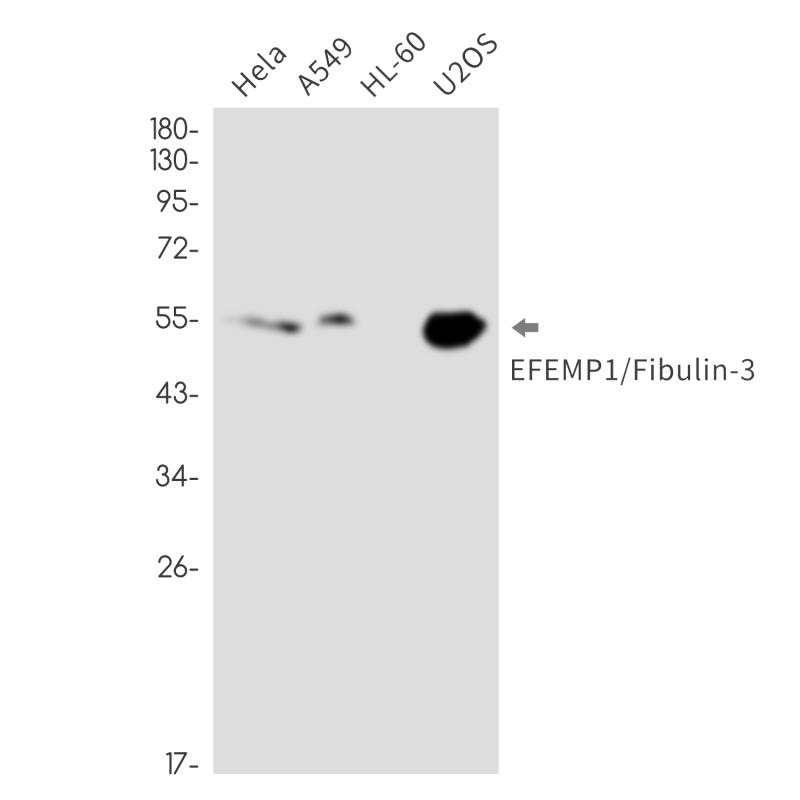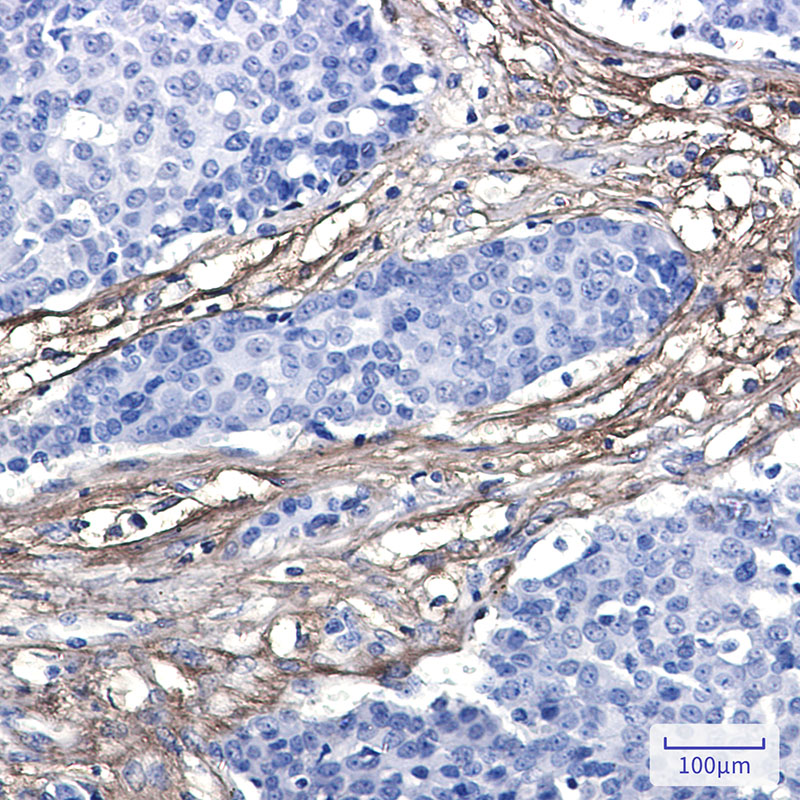

| WB | 1/500-1/1000 | Human,Mouse,Rat |
| IF | 1/20 | Human,Mouse,Rat |
| IHC | 1/50-1/100 | Human,Mouse,Rat |
| ICC | 技术咨询 | Human,Mouse,Rat |
| FCM | 咨询技术 | Human,Mouse,Rat |
| Elisa | 咨询技术 | Human,Mouse,Rat |
| Aliases | DHRD; DRAD; FBNL; MLVT; MTLV; S1-5; FBLN3; FIBL-3; Fibulin-3 |
| Entrez GeneID | 2202 |
| WB Predicted band size | Calculated MW: 55 kDa; Observed MW: 55 kDa |
| Host/Isotype | Rabbit IgG |
| Antibody Type | Primary antibody |
| Storage | Store at 4°C short term. Aliquot and store at -20°C long term. Avoid freeze/thaw cycles. |
| Species Reactivity | Human |
| Immunogen | Recombinant protein of human EFEMP1/Fibulin-3 |
| Formulation | Purified antibody in TBS with 0.05% sodium azide,0.05%BSA and 50% glycerol. |
+ +
以下是关于EFEMP1抗体的3篇参考文献示例(信息经简化整理):
1. **文献名称**:*EFEMP1 suppresses malignant glioma growth and exerts its action within the tumor extracellular compartment*
**作者**:Hu Y et al.
**摘要**:研究通过免疫组化和Western blot分析EFEMP1在胶质瘤中的表达,发现其通过调控细胞外基质抑制肿瘤生长,高表达与患者预后改善相关。
2. **文献名称**:*Fibulin-3 antibodies: Diagnostic and prognostic biomarkers for age-related macular degeneration*
**作者**:Marmorstein AD et al.
**摘要**:开发针对EFEMP1(Fibulin-3)的抗体用于ELISA检测,发现其在年龄相关性黄斑变性患者血清中水平升高,提示其作为疾病诊断标志物的潜力。
3. **文献名称**:*EFEMP1 promotes ovarian cancer cell proliferation, invasion and cisplatin resistance*
**作者**:Zhu X et al.
**摘要**:利用EFEMP1抗体进行免疫荧光和Western blot实验,证明其在卵巢癌中通过PI3K/AKT通路促进肿瘤侵袭及化疗耐药,提示其作为治疗靶点的可能性。
注:以上内容为示例性概括,实际文献需通过PubMed/Google Scholar等平台检索确认。
EFEMP1 (EGF-containing fibulin extracellular matrix protein 1), also known as fibulin-3. is a secreted glycoprotein belonging to the fibulin family. It plays a critical role in extracellular matrix (ECM) organization, cell adhesion, and tissue remodeling by interacting with other ECM components like elastin, collagen, and matrix metalloproteinases (MMPs). EFEMP1 is implicated in various physiological and pathological processes, including angiogenesis, tumor progression, and age-related macular degeneration (AMD).
EFEMP1 antibodies are valuable tools for studying its expression, localization, and function in biological systems. They are widely used in techniques such as Western blotting, immunohistochemistry (IHC), and immunofluorescence (IF) to detect EFEMP1 in tissues or cell cultures. Research has linked EFEMP1 dysregulation to diseases like cancer (e.g., glioblastoma, ovarian, and pancreatic cancers), where it may act as a tumor suppressor or promoter depending on context, and in AMD, where EFEMP1 mutations cause abnormal ECM deposits in the retina.
Antibodies targeting EFEMP1 also aid in exploring its dual roles in ECM homeostasis and disease mechanisms, offering insights into potential therapeutic strategies. Commercial EFEMP1 antibodies are typically validated for specificity using knockout controls or siRNA-mediated silencing. However, variability in post-translational modifications or tissue-specific isoforms may require careful experimental optimization. Overall, EFEMP1 antibodies remain essential for unraveling its complex contributions to development, disease, and tissue repair.
×